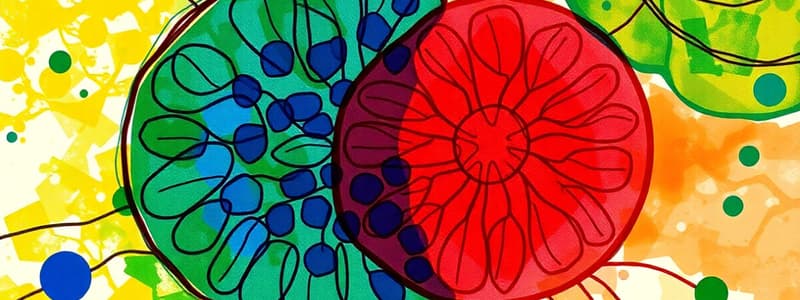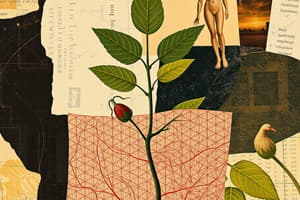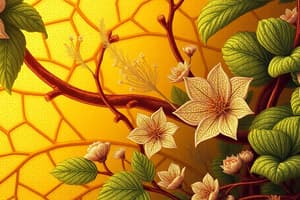Podcast
Questions and Answers
What is the primary function of the filament in a flower?
What is the primary function of the filament in a flower?
- To support the anther (correct)
- To aid in the process of photosynthesis
- To protect the ovary
- To absorb water from the soil
Which part of the female structure is sticky and allows pollen to adhere?
Which part of the female structure is sticky and allows pollen to adhere?
- Ovary
- Stigma (correct)
- Carpel
- Style
In aerobic respiration, which of the following is produced?
In aerobic respiration, which of the following is produced?
- Oxygen only
- 2 ATP
- Carbon dioxide only
- 36-38 ATP (correct)
What occurs in muscle cells when elite athletes perform intense exercise?
What occurs in muscle cells when elite athletes perform intense exercise?
Which of the following best describes the relationship between photosynthesis and cellular respiration?
Which of the following best describes the relationship between photosynthesis and cellular respiration?
What is the primary role of guard cells in plants?
What is the primary role of guard cells in plants?
Which of the following statements about xylem is correct?
Which of the following statements about xylem is correct?
Which reactants are necessary for the process of photosynthesis?
Which reactants are necessary for the process of photosynthesis?
In cellular respiration, which type requires the presence of oxygen?
In cellular respiration, which type requires the presence of oxygen?
What advantage do seed-producing plants have over non-seed producing plants?
What advantage do seed-producing plants have over non-seed producing plants?
What happens to pyruvate in muscle cells when there is a lack of oxygen?
What happens to pyruvate in muscle cells when there is a lack of oxygen?
What is the main function of phloem in a plant?
What is the main function of phloem in a plant?
Which process produces ATP using oxygen?
Which process produces ATP using oxygen?
Flashcards are hidden until you start studying
Study Notes
Plant Tissues
- Ground tissue is important for photosynthesis and food storage, provides structure, and includes cells that conduct photosynthesis.
- Dermal tissues prevent water loss.
- Xylem transports water, which is required for photosynthesis.
- Phloem transports glucose (sugar).
- Stomata are used for gas exchange.
- Plants with many leaves lose more water than plants with fewer leaves because the stomata are on the leaves.
- Guard cells control the opening and closing of stomata, regulating gas intake and release.
- Carbon dioxide enters plants through the stomata, and oxygen is released.
- Flowers are involved in reproduction.
- Ovules become seeds; seed coats protect the plant embryo until germination. This is an advantage for seed-producing plants.
- The ovary becomes the fruit.
Meristematic Tissue
- Meristematic tissue contains plant stem cells.
- Meristem cells divide to create more stem cells or differentiate into various plant organs, contributing to plant growth.
Photosynthesis
- Photosynthetic organisms, like zooxanthellae, produce glucose and oxygen.
- Reactants in photosynthesis are water and carbon dioxide. Light energy drives the process.
- Products of photosynthesis are glucose and oxygen.
- Increasing light intensity increases the rate of photosynthesis.
Cellular Respiration
- Cellular respiration creates ATP, which is chemical energy.
- Aerobic respiration requires oxygen.
- Anaerobic respiration does not require oxygen and is also called fermentation.
- Muscle cells switch to fermentation when oxygen is limited, producing lactic acid.
ATP
- ATP contains more energy than ADP.
- Limiting phosphorus reduces cellular energy because ATP requires phosphorus.
- ATP's readily releasable energy is stored in the bond between the second and third phosphate groups.
Plant Structures
- The male structure is called the stamen, consisting of the anther and filament.
- The anther produces pollen.
- The filament supports the anther.
- The female structure is called the carpel or pistil, including the stigma, style, and ovary.
- The stigma is the sticky top that traps pollen.
- The style connects the stigma to the ovary.
- The ovary contains ovules, which contain eggs.
Plant Adaptations
- Leaves are the sites of photosynthesis; chloroplasts absorb sunlight for this process.
- Cacti have adaptations to absorb carbon dioxide for photosynthesis while minimizing water loss.
- Root hairs increase surface area for water and nutrient absorption.
Processes
- Glucose in the presence of oxygen produces carbon dioxide and water through aerobic respiration
- Aerobic respiration produces a significant amount of ATP (36-38 ATP).
- Anaerobic respiration produces a small amount of ATP (2 ATP).
- Both aerobic and anaerobic respiration require glucose.
- When the body uses oxygen, carbon dioxide is produced and released.
- Elite athletes may experience muscle pain during intense exercise due to the switch to anaerobic respiration, producing less ATP.
- Energy flows from sunlight to photosynthesis to glucose to cellular respiration to ATP.
- Plants provide oxygen, which animals need.
- Animals release carbon dioxide, which plants need.
- The reactants of photosynthesis are the products of cellular respiration, and vice versa.
- Energy is stored during photosynthesis and released during cellular respiration.
- ATP's role is to transport energy.
Studying That Suits You
Use AI to generate personalized quizzes and flashcards to suit your learning preferences.




